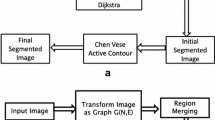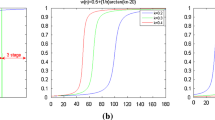Abstract
In this paper, we propose a novel variational method for color image segmentation using modified geodesic active contour method. Our goal is to detect Object(s) of Interest (OOI) from a given color image, regardless of other objects. The main novelty of our method is that we modify the stopping function in the functional of usual geodesic active contour method so that the new stopping function is coupled by a discrimination function of OOI. By minimizing the functional, the OOI is segmented. Firstly, we study the pixel properties of the OOI by sample pixels visually chosen from OOI. From these sample pixels, by the principal component analysis and interval estimation, the discrimination function of whether a pixel is in the OOI is obtained probabilistically. Then we propose the energy functional for the segmentation of OOI with new stopping function. Unlike usual stopping functions defined by the image gradient, our improved stopping function depends on not only the image gradient but also the discrimination function derived from the color information of OOI. As a result, better than usual active contour methods which detect all objects in the image, our modified active contour method can detect OOI but without unwanted objects. Experiments are conducted in both synthetic and natural images. The result shows that our algorithm is very efficient for detecting OOI even the background is complicated.
Similar content being viewed by others
References
L. Alvarez, P.L. Lions, and J.M. Morel, “Image selective smoothing and edge detection by nonlinear diffusion (II),” SIAM J. Numer. Anal., Vol. 29, pp. 845–866, 1992.
T.W. Anderson, An Introduction to Multivariate Statistical Analysis, 2nd Edition, Wiley: New York, 1984.
V. Caselles, F. Catte, T. Coll, and F. Dibos, “A geometric model for active contours in image processing,” Numer. Math., Vol. 66, pp. 1–31, 1993.
V. Caselles, R. Kimmel, and G. Sapiro, “Geodesic active contours,” in Proc. Int. Conf. Comput. Vis. ’95, Boston, MA, pp. 694–699, June 1995.
V. Caselles, R. Kimmel, and G. Sapiro, “Geodesic active contours,” Int. J. Comput. Vis., Vol. 22, No. 1, pp. 61–79, 1997.
T. Chan and L. Vese, “Active contour without edges,” IEEE Trans. Image Process., Vol. 10, No. 2, pp. 266–277, 2001.
T. Chan, B.Y. Sandberg, and L. Vese, “Active contour without edges for vector-valued image,” J. Vis. Commun. Image Represent, Vol. 11, pp. 130–141, 2000.
T. Cootes, C. Taylor, D. Cooper, and J. Graham, “Active shape models-their training and application,” Comput. Vis. Image Und., Vol. 61, pp. 38–59, 1995.
R. Goldenberg, R. Kimmel, E. Rivlin, and M. Rudzsky, “Fast geodesic active contours,” IEEE Trans. Image Process., Vol. 10, pp. 1467–1475, 2001.
M. Kass, A. Witkin, and D. Terzopoulos, “Snakes: Active contour models,” Int. J. Comput. Vis., Vol. 1, pp. 321–331, 1988.
G. Kühne, J. Weickert, M. Beier, and W. Effelsberg, “Fast implicit active contour models,” DAGM 2002, LNCS 2449, pp. 133–140, 2002.
M. Leventon, E. Grimson, and O. Faugeras, “Statistical shape influence in geodesic active contours,” in Proc. IEEE Conf. Comp. Vision and Patt. Recog., pp. 316–322, 2000.
S.J. Osher and J.A. Sethian, “Fronts propagating with curvature dependent speed: Algorithms based on Hamilton-Jacobi formulations,” J. Comput. Phys., Vol. 79, pp. 12–49, 1988.
N. Paragios and R. Deriche, “Godesic active regions for supervised texture segmentation,” Int. J. Comput. Vis., Vol. 46, pp. 222–247, 2002.
L. Pi, C.M. Shen, and F. Li, “A new variational formulation for segmenting desired objects in color images,” preprint, available at: http://euler.math.ecnu.edu.cn/preprint/.
G. Sapiro, “Color snakes,” Technical Report No. 113, 1995, Hewlett-Packard Labs.
G. Sapiro and D.L. Ringach, “Anisotropic diffusion of multivalued images with applications to color filtering,” IEEE Trans. Image Process., Vol. 5, pp. 1582–1586, 1996.
J.A. Sethian, “A review of recent numerical algorithms for hypersurfaces moving with curvature dependent flows,” J. Diff. Geom., Vol. 31, pp. 131–161, 1989.
C.M. Shen, L. Pi, F. Li, and J. Fan, “Burn scar delineation from Landsat imagery using modified Chan-Vese model,” in Proceedings of the 26th Asian Conference on Remote Sensing, 2005.
N. Sochen, R. Kimmel, and R. Malladi, “A general framework for low level vision,” IEEE Trans. Image Process., Vol. 7, pp. 310–318, 1998.
Author information
Authors and Affiliations
Corresponding author
Additional information
Ling Pi received her PhD from the Department of Mathematics, East China Normal University in 2006. She is currently a lecturer in the Department of Mathematics, Shanghai Jiao Tong University. Her work involves the application of geometric and analytic methods to problems in image processing.
Jinsong Fan received his MSc degree in mathematics from East China Normal University, Shanghai, China in 1996. Currently, he is a lecturer in the School of Mathematics and Information Science at Wenzhou University. His research interests include image processing and pattern recognition.
Chaomin Shen received the MSc degree in Mathematics from the National University of Singapore (NUS) in 1998. He worked in the Centre for Remote Imaging, Sensing and Processing (CRISP), NUS as an associate scientist during 1998 to 2004. Currently he is a lecturer in Joint Laboratory for Imaging Science & Technology and Department of Computer Science, East China Normal University. His research interests include remote sensing applications and variational methods in image processing.
Rights and permissions
About this article
Cite this article
Pi, L., Fan, J. & Shen, C. Color Image Segmentation for Objects of Interest with Modified Geodesic Active Contour Method. J Math Imaging Vis 27, 51–57 (2007). https://doi.org/10.1007/s10851-006-9797-3
Published:
Issue Date:
DOI: https://doi.org/10.1007/s10851-006-9797-3




